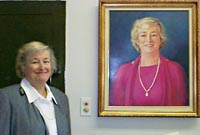 NBT
Interview: Linnell
Bowen
NBT
Interview: Linnell
Bowenwith Sandra Martin and Christy Grimes
 NBT
Interview: Linnell
Bowen
NBT
Interview: Linnell
Bowen
with Sandra Martin and Christy Grimes
Maryland Hall for the Creative
Arts Wants You
photo courtesy of Marion E. Warren
It's a good thing that schools in the 1930s were built to last. With Floyd flinging rain and wind like a modern-day Zeus, anybody out on the streets September 16 was eagerly seeking sanctuary. Our sanctuary, Maryland Hall for the Creative Arts, seemed likely to withstand this little blow. Not only had it stood since before hurricanes had names, it had also survived the daily presence of nearly a half-century of high schoolers.
Of course the old school has changed, becoming more playful in its association with the arts. It's surrounded by gardens. Sculptural cutouts of bright-colored people and dogs romp in the front yard. Handprints have been preserved in the concrete of the sidewalks. In the entranceway, in place of a vast wall of institutional glazed brick, visitors are now greeted by a curved theatre marquee displaying not only upcoming Hall events but also works by Maryland Hall artists.
Inside, you'd hardly have known Floyd was blowing. Nor that Maryland Hall was closed for the duration of his visit. Phones rang, visitors called, artists encountered the muses and custodians kept the terrazzo floors dry and gleaming despite the dripping of all who entered these venerable halls.
Through it all, Linnell Bowen, executive director of Maryland Hall for the Creative Arts since 1996, acted the part of the many-handed Hindu goddess Durga, letting nothing stray too far from her control.
Which is saying something when dodging hurricanes while juggling Chinese vases in preparation for the Hall's 20th anniversary celebration.
"You're writers. What should we say on the poster we're inscribing for Mrs. Glendening? It's got to go to the framer tomorrow," says Bowen, keeping one more ball from falling. In the air at any given moment are so many that the 59-year-old organizer, historian and self-styled patron of the arts can't count them.
Counting them is not one of her jobs. Neither is saying what art is. But getting you inside this latter-day incarnation of the old Annapolis High School - where Bowen attended high school herself and, five years later, began her teaching career - that is her job. It's a job Linnell Bowen pursues with the determination of Uncle Sam who Wants You.
It's a job that keeps Maryland Hall humming at all hours of the day and
many hours of the night with a heady mix of art and ages.
It's a job for which Bowen is uniquely suited, not only by her two previous stints at the old Annapolis High School but also by all she's done in between, including directing Annapolis' 300 year birthday celebration and overseeing education, development and public relations for Historic Annapolis Foundation.
"Foremost in our minds when we chose Linnell was her insight into Annapolis and its culture," says Dennis Younger, chairman of Maryland Hall's board of directors.
Meet Bowen in her own words.
banner photo by Christy Grimes
Q As executive director of Maryland Hall, you're also its chief saleswoman. What's here that we can't do without?
A My goal is to get all 500,000 people of Anne Arundel County in here once.
There's magic at Maryland Hall, and I would love for others to experience that magic. There is something for every age here and every skill level. I kid you not when I talk about going to the recitals and being so touched watching these little children or seeing ladies older than us in their tutus doing ballet. There's just something special about that, and they're so happy. I was a school teacher. I want to see people learn. Now I have 5,000 students.
I'm studying photography here now, and the people in my class, including the instructor, have such passion for what they do. All the artists here have such a passion for what they do.
We have all sorts of live performances, too, and once you sit through one, you see there's nothing like it.
Q What is Maryland Hall's job in the community?
A Over the years I think it's really become kind of the cultural hub, certainly of Annapolis, and I hope of Anne Arundel County.
We're the catalyst for arts in our community. As I see it, our role is to produce the next generation of artists, dancers, singers and poets. That's probably what we do the very best.
Besides this, we have exhibition spaces. Our three galleries may be small and modest, but during intermission of the symphony, for example, people can see new artwork by local artists.
We've also become a community center because we have lectures and all kinds of other things that aren't necessarily artistic, but they're related. In the three years since our auditorium has been climate controlled, we've opened it to more and more people. We're having a show from the Hispanic community this fall, Noche de Gala. We'll collaborate with anyone who has a really good community project.
Q You've got so much going on that we'd better break it down into parts. Mayor Dean Johnson was inaugurated on the stage at Maryland Hall You were up there making the introduction. What other public events take place here?
A We've also sponsored a city-county symposium
on smart growth. We have all kinds of meetings here for the city and county.
Annapolis and Anne Arundel Chamber of Commerce come here also.
Q Children seem to have a special place at Maryland Hall.
A Someone has to expose our children to the arts. If every child in Anne Arundel County could see something live, at the least they would have an appreciation of the skill involved. But there's more.
Some of those young people out there in our community could be those skilled performers, and we need to touch them. The Chesapeake Youth Symphony Orchestra performs here a lot. They're unbelievable. I'm always blown away. All kids. And they're fabulous. And every time they perform onstage, in an acoustically good environment, they learn more and get better.
Q Now tell us a little more about what Maryland Hall does for artists.
A We spawn these artists. Some of our students have their first sales here; it's a way to encourage them. They nurture each other and critique each others' work. For artists, Maryland Hall really is family. I didn't know that before I came here.
For people who have reached a level where they've taken all the classes they can but still want to develop, we have something called cooperatives, which I think is really neat. You pay a nominal fee that enables you to come here after hours and do pottery, photography or painting at your own speed and with your own little group. They have shows. And they're very successful. Those people, some of them have been here forever.
People don't realize that art is everywhere, including everyday life. There's wearable art, and there are people who design beautiful clothing and furniture, to offer a few examples. Our mission is to disseminate the idea that we - not just Maryland Hall, but our whole community - is a cultural center.
Our artists live next door, they live in your neighborhood, shop in the same stores you do and raise their children here. They're great citizens. We have 13 artists in residence. They're professional artists, and they're family.
Q Tell us about these artists-in-residence.
A Artists-in-residence have a studio of their own at Maryland Hall. It's a way for people not to have to work out of their homes, to get away from the distractions of home, of children and all that. The artists pay a nominal rent.
Q How does an artist get to be in residence at Maryland Hall?
A They have to be professional artists. We have applications, and we have a jury. They are juried and judged by their peers. Many of the artists have been here a long time. But if a vacancy happens to arise, we send out word to local artists.
Q Is the number always 13?
A That's all there can be. We only have 13 spaces. They would like it to double, and I could double it if we had the space. That will be my answer to a lot of your questions, that we've absolutely run out of space. I can't even fit another class in this building.
Q Are the artists-in-residence all visual artists, or are some of them singers or dancers?
A All are visual artists, painters or photographers, but they're all different in what they do.
Q How does Maryland Hall work for performing arts and artists?
A Most of our performing artists are what we call resident companies. We have a lot of performing groups, but they don't have artists-in-residence studios. But the Annapolis Symphony Orchestra, Ballet Theatre of Annapolis, Annapolis Opera and Annapolis Chorale have offices here and perform here.
One small group, Footworks, teaches here. The arrangement is informal. They perform here on occasion.
Q Footworks Percussive Dance Ensemble is a first-rate, incredibly versatile group, as we in the audience saw last month at the Hall. How did they hook up with Maryland Hall?
A They've been teaching here for 20 years. One day this dancer from the company came tapping into my office.
"Have you ever performed here?" I asked her.
She said no. I asked her why that was, and she said, "nobody's ever asked me."
So I asked.
Their performance at the end of August sold out. It was their 20th anniversary show, and it was wonderful. I went to see Riverdance recently at Wolftrap. I love Riverdance, but $18 for Footworks at Maryland Hall compared to what they charge at Wolftrap, for what is really the same level of performance? We offer the same caliber, but we're affordable.
You come to Maryland Hall because we have the best teachers and the best programs. Not because we have the best building. We don't.
 Q Let's talk about your building.
How did the old Annapolis High School become Maryland Hall for the Creative
Arts?
Q Let's talk about your building.
How did the old Annapolis High School become Maryland Hall for the Creative
Arts?
A In 1979, the new high school was opened on Riva Road. This building was to be shut down. The founders of what would become Maryland Hall went to the then-superintendent of schools and pointed out they had been looking 10 years for a place to start an arts center. They'd been working years on plans for a symphonic hall, and they almost got one. But it just didn't happen, and as a second best they asked for the old high school. It had been empty for a while and had pigeons in the attic. But it was still in running shape. From there, things happened gradually.
The building is still under the Anne Arundel County Board of Education. They provide custodial services and snow removal, and they mow the grass. The janitor downstairs right now, Charles McGowan, was the janitor when I went to high school here in 1958.
Q Then your first job out of college brought your back here?
A Right here in this building, the same place I attended high school. I taught in room 205. My current office was the principal's office. My mother likes to say I haven't gone very far in 40 years.
Q While we're on the subject
of you, how did you get your first name?
A Linnell? It was my great-great-great grandmother's last name: Marie Linnell.
Q You've studied and worked in this building over four decades. How is it holding up at 67?
A This is a wonderful building. It's got good bones, as an architect once told me. In 1932 they built statements in schools. It's certainly worthy of restoration. As an effort of preservation, I think it's neat to take an abandoned building and fix it up and put it to good use, as Maryland Hall has done. They call that 'adaptive re-use' in preservation.
Q You've recently made many improvements
A We've had wonderful acoustic improvements. Bose Corporation gave us a whole new $30,000 sound system and installed it. Three years ago, we added air conditioning, and we now have climate control in the performance hall and downstairs in the old gym.
But our hall is as good as it's going to be. A big goal is a modern performing hall. Maybe this will happen in my lifetime.
Q What's the next step?
A My emphasis now is to get the building up to snuff. Our programs are wonderful, but we're performing them in a less than suitable environment.
We have a five-year capital campaign, which we'll launch when we get half the money. In the short term, we need to raise almost a million dollars for building maintenance. In addition to state grants, we hope to raise the bulk of the money through naming opportunities: You can have your name on a room, one of our 280 windows, even a brick in the wall. You can have a commemorative brick for $100. You can buy a seat in the auditorium for $500.
Q Is there a long term?
A It's scary. Ten million dollars. Seven to 10 million. It's a wonderful, functional building, but this new generation likes amenities. Part of the charm of this building is that it's an old school and always will be. We're looking at air conditioning for the whole building, not just the auditorium. We're looking at geo-thermal, that seems to be the most cost-effective. And we need a sprinkler system.
Q If someone reading this article thinks, "that's a place I wouldn't mind giving a little money," what should they do?
A They should call me tomorrow.
Q What's up in the immediate future?
A We would like to have more year-round programs, and things like summer day camp and Kindermusik. We're trying to get a movie series started. It's amazing all the groups that want to use this building. So we need to expand our programs. If we had more space we could do more things.
Q So you're thinking of putting on an addition to the Hall?
A Well, spreading out somewhere. We do have satellite classes, like in Severna Park, Lothian and Odenton. But they're better confined to a building equipped for the purpose. It's better to have our own space.
Q We're learning what Maryland Hall has to offer our community. Does this area have anything rare and special to offer Maryland Hall?
A We have the U.S. Naval Academy band, which basically lives in our community.
The band director, Ralph Gambone, was one of my students when I taught high school. He was a fabulous musician and his goal in life was to be director of the Naval Academy Band.
When he achieved his dream, I said, 'okay Ralph, paybacks are hell.' So the Academy band came and played and got a standing ovation. The audience loved it, the band loved it, his family came: It was a love-in.
Then he became director of the U.S. Navy Band and brought them to play at Maryland Hall, too. That's the magic.
Q Are there other reasons Annapolis is such a rich resource for art?
A The beauty of Annapolis. I'll stand at the head of Main Street and the view takes my breath away, especially since they got rid of the overhead wires.
The beauty brings a lot of people. Twenty years ago you didn't have the galleries and the economic development that comes from art. I am stunned by the number of art galleries we have here today. Obviously somebody's buying art.
Finally people in politics understand that it's a necessary part of economic growth. You need good citizens to sustain your community, and art is part of that. Some people seem to think it's as simple as, well, if you have a bunch of old houses and you save them the tourists will come. The tourists come for other things too. Why do people visit, stay in the hotels, and spend money? Because of the Naval Academy? Sure, but it's more than that. Because of the water, it's a nice place to visit. And it's beautiful. Those hanging baskets downtown are gorgeous.
Q So you're in favor of the hanging baskets? That's a controversial statement .
A I am. I testified for the public record. The great cities of the world have hanging baskets. We have to modernize a little. I want them all over West Street. And I want them on the street that leads to Maryland Hall.
Q So what is this art you're all about at Maryland Hall?
A Art, like beauty, is in the eye of the beholder. What else can it be? I mean, when some little child who can't dance is up there tap dancing, who has maybe two lessons, it brings tears to my eyes. Once the tintinnabulation subsides, you're experiencing art. Especially if you're the parent.
You have to allow yourself to see the creativity of another person. I don't find every form of art beautiful, but I find the act of creating beautiful.
That's what's nice about Maryland Hall. You can take a course at any level. You're not rated so much. And especially for children, it's not about performance. It's what you learn. Performance can come later. We're probably anti-performance because we want children to love art.
Q Isn't there some way you can tell us what art is so we know what it does in our community?
A That's hard. I'm not an artist, I'm a patron of the arts.
Q What arts do you patronize?
A I buy art, I go to plays, I go to museums. I've seen The Phantom of the Opera about 10 times. (If my husband knows that he'll kill me.) I also love architecture. That's why I love the city of Annapolis. We have fabulous architecture. You don't have to be trained in something to say it's beautiful, or to create it or to enjoy it.
Q So art has something to do with beauty and with making its beholders happier?
A Absolutely. And it has something to do with community pride. This is where Maryland Hall comes in. Why are you proud of your community? Why do people move here? Is it just because of the Bay and the crabs? I think it's because the community has things people want.
Q How is our community different because of the presence of Maryland Hall over these 20 years?
A I've only been here three, but I've always appreciated that in my own back yard I can always go see first-class opera, symphony, ballet and chorale music. I don't have to go to Washington and Baltimore. Many people think they do. But once we get them here they'll say, "hey, that was great!"
We're never going to be the Meyerhoff or the Kennedy. But in your backyard, you have some wonderful artists. I don't have to go to Europe to buy art. I can do it right here.
Q You're celebrating Maryland Hall's 20th anniversary all weekend. Tell us what's happening.
A We're celebrating with two days of activities called Arts Alive! The celebration begins Friday at 6pm with a reception in the downstairs gym and a silent, closed-bid auction of Maryland Hall Art. Bidding continues through Saturday afternoon. At 8pm, there's a by-reservation dinner with special guests First Lady Frances Glendening, County Executive Janet Owens and Annapolis Mayor Dean Johnson.
The focus on Saturday is family fun. In the afternoon, Maryland Hall students and their instructors will demonstrate their talents and teaching in a picnic setting on our grounds, at 801 Chase Street.
There'll be many classes informally conducted outdoors, so visitors can see teachers and students at work and talk with them. Many of their finished works will be on display.
Everyone can try their hand in making art as a large, paint-by-numbers version of our colorful "Arts Alive" collage - made by student Kathryn Shepard Leonard - comes to life during the festivities.
Performing arts students - dancers, musicians and singers - will keep a stage open all day, leading to a rousing finale in which all guests join in with Phyllis Denton and her Kindermusik classes.
We hope you and all your readers will stop by to see just what we offer for you and your children. The 11am to 3pm celebration is free and parking is ample. Bring your own picnic or buy hot dogs, sodas and snacks on the lawn.
The celebration continues Saturday evening, with our homecoming. We'll be honoring and entertained by many long-time friends in a performance of music and dance followed by a dessert reception with the artists. All are local stars.
There are some neat human interest stories here. One of our performers at the 20th anniversary weekend is Kelly Isaacs, who is a student here. He's going to do a little dance at this thing, it's a very home-spun, local thing, but it's so neat. He performs on Broadway, in Bring in da Noise, Bring in da Funk, and he might be the next Gregory Hines, who knows? The kid's got that kind of talent.
Also, we're honoring jazz guitarist Charlie Byrd, who is famous the world over, yet no one's ever honored him here; jazz singer Ethel Ennis, who is just fabulous; wonderful pianist Stef Scaggiari; folk artist Mac Bailey. Mama Jama, who used to play here all the time, starts the evening off with their infectious world-beat rhythms. Then you have Footworks, also celebrating their 20th anniversary. So it's a real mix. It's a chance to say these are our friends - come meet them.
| Issue 38 |
Volume VII Number 38
September 23-29, 1999
New Bay Times
| Homepage |
| Back to Archives |